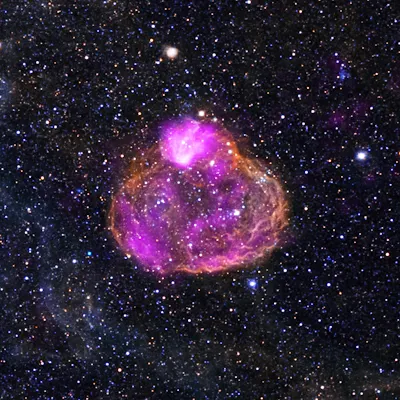Η
σουπερφυσαλίδα DEM
L50 στο Μεγάλο Νέφος
του Μαγγελάνου. This composite image shows the superbubble DEM L50
(a.k.a. N186) located in the Large Magellanic Cloud about 160,000 light years
from Earth. Superbubbles are found in regions where massive stars have formed
in the last few million years. The massive stars produce intense radiation,
expel matter at high speeds, and race through their evolution to explode as
supernovas. The winds and supernova shock waves carve out huge cavities called
superbubbles in the surrounding gas.
Το
διαστημικό τηλεσκόπιο Chandra της NASA εντόπισε και φωτογράφισε μια
«υπερφυσαλίδα», όρος που περιγράφει ένα ενδιαφέρον και ιδιαίτερα εντυπωσιακό
κοσμικό φαινόμενο. Το Chandra εντόπισε την DEM L50, μια υπερφυσαλίδα που
βρίσκεται στο Μεγάλο Νέφος του Μαγγελάνου, ένα γειτονικό και μικρότερο από το
δικό μας γαλαξία. Η υπερφυσαλίδα DEM L50 παρουσιάζει ιδιαίτερο ενδιαφέρον
επειδή όπως διαπίστωσαν οι επιστήμονες εκπέμπει 20 φορές περισσότερη
ηλεκτρομαγνητική ακτινοβολία (ακτίνες Χ) από εκείνη που συνήθως εκπέμπουν οι υπερφυσαλίδες.
X-ray
Optical
X-rays from NASA's
Chandra X-ray Observatory are shown in pink and optical data from the
Magellanic Cloud Emission Line Survey (MCELS) are colored in red, green and
blue. The MCELS data were obtained with the University of Michigan's 0.9-meter
Curtis Schmidt telescope at Cerro Tololo Inter-American Observatory (CTIO). The
shape of DEM L50 is approximately an ellipse, with a supernova remnant named
SNR N186 D located on its northern edge (roll your mouse over the image above
for labels).
Like another superbubble
in the LMC, N44 (see last year's press release), DEM L50 gives off about 20
times more X-rays than expected from standard models for the evolution of
superbubbles. A Chandra study published in 2011 showed that there are two extra
sources of the bright X-ray emission: supernova shock waves striking the walls
of the cavities, and hot material evaporating from the cavity walls. Credit: X-ray: NASA/CXC/Univ of
Michigan/A.E.Jaskot, Optical: NOAO/CTIO/MCELS




Δεν υπάρχουν σχόλια:
Δημοσίευση σχολίου